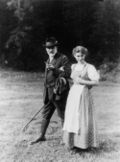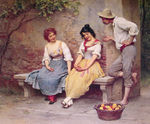Human sexuality
|
|
|---|
|
Types of relationships Boyfriend · Girlfriend Friendship · Kinship Mistress (lover) · Cicisbeo · Concubinage · Courtesan · Romantic relationship events Feelings and emotions Human practices Relationship abuse |
Human sexuality is how people experience the erotic and express themselves as sexual beings.[1] Frequently driven by the desire for sexual pleasure, human sexuality has biological, physical, and emotional aspects. Biologically, it refers to the reproductive mechanism as well as the basic biological drive that exists in all species and can encompass sexual intercourse and sexual contact in all its forms. Emotional aspects deal with the intense emotions relating to sexual acts and associated social bonds. Physical issues around sexuality range from purely medical considerations to concerns about the physiological or even psychological and sociological aspects of sexual behaviour.
The term can also cover cultural, political, legal and philosophical aspects. It may also refer to issues of morality, ethics, theology, spirituality or religion and how they relate to all things sexual.
Contents |
Nature vs nurture debate
Recent studies on human sexuality have highlighted that sexual aspects are of major importance in building up personal identity and in the social evolution of individuals:[2]
| “ | Human sexuality is not simply imposed by instinct or stereotypical conducts, as it happens in animals, but it is influenced both by superior mental activity and by social, cultural, educational, and normative characteristics of those places where the subjects grow up and their personality develops. Consequently, the analysis of sexual sphere must be based on the convergence of several lines of development such as affectivity, emotions, and relations. | ” |
Deleuze and Guattari, in their 1972 Anti-Oedipus, discuss how sexuality is a powerful force that invests all social activities:[3]
| “ | Familialism maintains that sexuality operates only in the family [...] the truth is that sexuality is everywhere: the way a bureaucrat fondles his records, a judge administers justice, a business causes money to circulate; the way the burgeoisie fucks the proletariat; and so on. And there is no need to resort to metaphors, any more than for the libido to go by way of metamorphoses. | ” |
Biology and physiology
The biological aspects of human sexuality deal with human reproduction and the physical means with which to carry it out. They also deal with the influence of biological factors on other aspects of sexuality, such as organic and neurological responses,[4] heredity, hormonal issues, gender issues and sexual dysfunction.[1]
Benefits
Apart from the possibility of its resulting in successful pregnancy and childbirth, sex has a wide range of health benefits including relief from stress, more immunity through increased immunoglobulin A, reduced risk of heart attack and of prostate cancer, and sounder sleep.[5]
Sociocultural aspects

Human sexuality can also be understood as part of the social life of humans, governed by implied rules of behavior and the status quo. This focus narrows the view to groups within a society.[1] The sociocultural aspect examines influences on and from social norms, including the effects of politics and the mass media. Such movements can help to bring about massive changes in the social norm — examples include the sexual revolution and the rise of feminism.[6][7]
The link between constructed sex meanings and racial ideologies has been studied. Sexual meanings are constructed to maintain racial-ethnic-national boundaries, by denigration of "others" and regulation of sexual behavior within the group. "Both adherence to and deviation from such approved behaviors, define and reinforce racial, ethnic, and nationalist regimes."[8][9]
The age and manner in which children are informed of issues of sexuality is a matter of sex education. The school systems in almost all developed countries have some form of sex education but the nature of the issues covered varies widely. In some countries (such as Australia and much of Europe) "age-appropriate" sex education often begins in pre-school, whereas other countries leave sex education to the pre-teenage and teenage years.[10] Sex education covers a range of topics, including the physical, mental, and social aspects of sexual behavior.
Psychological aspects

Sexuality in humans generates profound emotional and psychological responses. Some theorists identify sexuality as the central source of human personality.[11]
Psychological studies of sexuality focus on psychological influences that affect sexual behavior and experiences.[1] Early psychological analyses were carried out by Sigmund Freud, who believed in a psychoanalytic approach. He also conjectured the concepts of erogenous zones, psychosexual development, and the Oedipus complex, among others.[12]
Behavior theorists such as John B. Watson and B. F. Skinner examine the actions and consequences and their ramifications. These theorists would, for example, study a child who is punished for sexual exploration and see if they grow up to associate negative feelings with sex in general.[13] Social-learning theorists use similar concepts, but focus on cognitive activity and modeling.
Gender identity is a person's own sense of identification as female, male, both, neither, or somewhere in between. The social construction of gender has been discussed by a wide variety of scholars, Judith Butler notable among them. Recent contributions consider the influence of feminist theory and courtship research.[14][15]
Sexual behavior

Human sexual behavior, driven by the desire for pleasure, encompasses the search for a partner or partners, interactions between individuals, physical, emotional intimacy, and sexual contact which may lead to foreplay, masturbation and ultimately orgasm.[16]
Sexual attraction
Sexual attraction is an important aspect of the sexuality of the person being observed, as well as of the person observing. Each person determines the qualities which they find attractive, which vary from person to person. A person's sexual orientation has a significant influence on which qualities they will find attractive. The qualities which people can find sexually attractive may depend on the physical quality, including both looks and movements of a person but can also be influenced by voice or smell as well as by individual preferences resulting from a variety of genetic, psychological, and cultural factors.
Creating a relationship


People both consciously and subconsciously seek to attract others with whom they can form deeper relationships. This may be for companionship, for procreation, for an intimate relationship, besides other possible purposes. This involves interactive processes whereby people find and attract potential partners, and maintain a relationship. These processes, which involve attracting a partner and maintaining sexual interest, can include:
- Flirting can be used to attract the sexual attention of another in order to encourage romance or sexual relations, and can involve body language, conversation, joking or brief physical contact.[17]
- Seduction is the process whereby one person deliberately enticing another to engage in some sort of human sexual behavior.[18] The medium of communication of sexual interest can be verbal or visual.
- Dating is the process of arranging meetings or outings with a potential partner with a view to investigating or enhancing their suitability for an intimate partnership.
- The prospect of physical intimacy is at times the most effective means of sexual attraction, and can be by way of an expression of feelings such as close friendship or love, including holding hands, hugging, kissing, or caressing.
Sexual morality
Most world religions have sought to address the moral issues that arise from people's sexuality in society and in human interactions. Each major religion has developed moral codes covering issues of sexuality, morality, ethics etc., which have sought to influence people's sexual activities and practices. However, the impact of religious teaching has at times been limited. For example, despite most religions disapproving extramarital sexual relations, it has always been widely practiced, to a large extent due to peoples' sexuality.
Child sexuality
In the past, children were often assumed not to have sexuality until later development. Sigmund Freud was one of the first researchers to take child sexuality seriously. While his ideas, such as psychosexual development and the Oedipus conflict, have been rejected or labeled obsolete, acknowledging the existence of child sexuality was a milestone.[19] Alfred Kinsey also examined child sexuality in his Kinsey Reports. Children are naturally curious about their bodies and sexual functions — they wonder where babies come from, they notice anatomical differences between males and females, and many engage in genital play (often mistaken for masturbation). Child sex play includes exhibiting or inspecting the genitals. Many children take part in some sex play, typically with siblings or friends.[19] Sex play with others usually decreases as children go through their elementary school years, yet they still may possess romantic interest in their peers. Curiosity levels remain high during these years, but it is not until adolescence that the main surge in sexual interest occurs.[19]
Sexuality in late adulthood
Changes in sexual behavior occur with age and while humans in late adulthood may be impaired by infirmity, relationship needs such as closeness and sensuality remain. Aging produces changes in sexual performance. Men are more likely to experience these changes than women. For men, orgasms become less frequent and usually need more direct stimulation to produce an erection. One out of four men, ages 65 to 80, had severe problems getting or keeping erections and this percentage increased with men over 80 years of age. Yet, the use of drugs to treat erectile dysfunction increases the expectations of older adults to have sex. Despite medical complications and opinions that people in late adulthood should be asexual, many older adults continue to engage in sexual intercourse. The results of a recent interview study involving 3,000 adults 57 to 85 years of age have shown that health plays a role in the level of older adults' sexual activity. The percentage of sexually active older adults is higher for those that are in good health than those in poor health. Older women may be less sexually active due to outliving their partners or men's tendency to marry younger women. While older adults engage in sexual activity, intimacy and companionship tend to be more important than sex.[19]
Sexuality in history

Art and artifacts from past eras help to portray human perception of sexuality of the time.[1]
Ancient civilizations

Many of the ancient civilisations provide evidence of developments in sexuality. In particular:
- Egypt: The couple Khnumhotep and Niankhkhnum, now buried in a joint Fifth-dynasty (2498–2345 BC) era tomb in Saqqara, Egypt, are the oldest recorded same-sex couple in human history. The Ancient Egyptians related the cult of phallus with Osiris. When Osiris' body was cut in 13 pieces, Set scattered them all over Egypt and his wife Isis retrieved all of them except one, his penis, which was swallowed by a fish (see the Legend of Osiris and Isis). The phallus was a symbol of fertility, and the god Min was often depicted ithyphallic (with a penis).
- India: Ancient texts from Hinduism, Buddhism and Jainism such as the Vedas reveal moral perspectives on sexuality, marriage and fertility prayers. The epics of ancient India, the Ramayana and Mahabharata, possibly from as early as 1400 BCE, later influenced Chinese, Japanese, Tibetan and South East Asian culture. They indicate that sex was considered a mutual duty between a married couple, but where sex was considered a private affair. The most publicly known sexual literature of India are the texts of the sixty-four arts.
- Mesopotamia: In ancient Mesopotamia, Ishtar was the primary Goddess of life, men and women, nature and fertility, sex, sexual power and birth. Ishtar was also the goddess of war and weapons and any victory was celebrated in her temples with offerings of produce and money as well as through a feast and orgy of sex and fornication with holy temple prostitutes.
- China: In the I Ching (The Book of Changes, a Chinese classic text dealing with what would be in the West termed metaphysics), sexual intercourse is one of two fundamental models used to explain the world. Heaven is described as having sexual intercourse with Earth. The male lovers of early Chinese men of great political power are mentioned in one of the earliest great works of philosophy and literature, the Zhuang Zi.
- Japan: In perhaps the earliest novel in the world, the Genji Monogatari (Tale of Genji), dating back to around the 11th century AD, eroticism is treated as a central part of the aesthetic life of members of the nobility.
- Greece: In ancient Greece, the phallus, often in the form of a herma, was an object of worship as a symbol of fertility. One ancient Greek male idea of female sexuality was that women envied penises of males. Wives were considered as commodity and instruments for bearing legitimate children. They had to compete sexually with eromenoi, hetaeras and slaves in their own homes.
- Rome: Ancient Roman civilization included celebrations associated with human reproductive organs. Over time there emerged institutionalization of voluntary sex as well as prostitution. This resulted in a virtual sexual caste system in Roman civilization – different grades and degrees of sexual relationships. Apart from the legally wedded spouses, a number of males used to have Delicatue, mistresses of wealthy and prominent men. The next were the Famosae, mostly the daughters and even wives of the wealthy families who enjoyed sex for its own sake. There was another class known as Lupae, willing to have sexual union with anyone for a price. Copae were the serving girls in the taverns and inns and who did not mind being hired as bedmates for the night by travelers.
Modern developments
In contemporary academia, sexuality is studied in the fields of sexology and gender and sexuality studies, among many other fields.
Sexology, the study of sexual interests, behavior, and function, covers sexual development and sexual relationships including sexual intercourse. It also documents the sexualities of groups such as the disabled, children, and the elderly.[20]
Alfred Kinsey became interested in the different forms of sexual practices around 1933 when he developed the Kinsey Scale which ranges from 0 to 6, where 0 is exclusively heterosexual and 6 is exclusively homosexual. His Kinsey Reports starting with the publication of Sexual Behavior in the Human Male in 1948 and Sexual Behavior in the Human Female in 1953 contributed to the sexual revolution of the 1960s.
See also
- Index of human sexuality articles
- Sex magic
- Sexologies: European Journal of Sexual Health (Revue Européenne de Santé Sexuelle)
- Sexology
- Sexualization
Footnotes
- ↑ 1.0 1.1 1.2 1.3 1.4 Rathus, Spencer A., Jeffrey S. Nevid, and Lois Fichner-Rathus. 2007. Human Sexuality in a World of Diversity. Allyn & Bacon.
- ↑ Boccadoro L., Carulli S., (2008) Il posto dell'amore negato. Sessualità e psicopatologie segrete (The place of the denied love. Sexuality and secret psychopathologies – Abstract). Tecnoprint Editrice, Ancona. ISBN 978-88-95554-03-7
- ↑ Deleuze and Guattari (1972) Anti-Oedipus pp. 322, 114–5
- ↑ Ellen Ross, Rayna Rapp Sex and Society: A Research Note from Social History and Anthropology Comparative Studies in Society and History, Vol. 23, No. 1 (Jan., 1981), pp. 51–72
- ↑ Kathleen Doheny: 10 Surprising Health Benefits of Sex. From WebMD. Retrieved 11 October 2009.
- ↑ . Escoffier, Jeffrey. (Editor): Sexual Revolution. Running Press, 2003. ISBN 1560255250. Retrieved 12 October 2009.
- ↑ Betty Friedan, Who Ignited Cause in 'Feminine Mystique,' Dies at 85 – The New York Times, February 5, 2006. Retrieved 12 October 2009.
- ↑ Joane Nagel (August 2000). "Ethnicity and Sexuality". Annual Review of Sociology 26: 107–133. doi:10.1146/annurev.soc.26.1.107.
- ↑ Joane Nagel (2001). "Racial, Ethnic, and National Boundaries: Sexual Intersections and Symbolic Interactions". Symbolic Interaction 24 (2): 123–139. doi:10.1525/si.2001.24.2.123.
- ↑ Think Sex from TheAge.com.au. Retrieved 11 October 2009.
- ↑ John Russon (2009). Bearing Witness to Epiphany: Persons, Things, and the Nature of Erotic Life. Albany: State University of New York Press. ISBN 978-1-4384-2504-7. http://www.amazon.com/Bearing-Witness-Epiphany-Contemporary-Continental/dp/143842504X.
- ↑ What is Psychosexual Development? Pschology from About.com. Retrieved 12 October 2009.
- ↑ B. F. Skinner and behaviorism. From essortment. Retrieved 12 October 2009.
- ↑ Buss, D.M. (2002) Human mating strategies. Samdunfsokonemen, 4: 48–58.
- ↑ Farrell, W. (1988) Why Men Are The Way They Are, New York: Berkley Books
- ↑ Sex. From Likeitis.org. Retrieved 12 October 2009.
- ↑ SIRC Guide to Flirting. What Social Science can tell you about flirting and how to do it. Retrieved 13 October 2009.
- ↑ Greene, Robert (2003). The Art of Seduction. Penguin Books. ISBN 0-14-200119-8.
- ↑ 19.0 19.1 19.2 19.3 Santrock, J.W. (2008). A Topical Approach to Life-Span Development (4thed.). New York: McGraw-Hill.
- ↑ Erwin J. Haeberle: A Brief History of Sexology. Humboldt-Universität zu Berlin. Retrieved 15 October 2009.
External links
- American Sexuality Magazine
- Glossario di sessuologia clinica – Glossary of clinical sexology
- History of Surveys of Sexual Behavior from Encyclopedia of Behavioral Statistics
- International Encyclopedia of Sexuality full text
- Janssen, D. F., Growing Up Sexually. Volume I. World Reference Atlas [full text]
- National Sexuality Resource Center
- Durex Global Sex Survey 2005 at data360.org
- POPLINE is a searchable database of the world's reproductive health literature.
- The Continuum Complete International Encyclopedia of Sexuality at the Kinsey Institute
- The Sexuality and Rights Institute
- The South and Southeast Asia Resource Centre on Sexuality
|
|||||||||||||||||||||||||||||
|
|||||||||||||||||||||||
|
||||||||